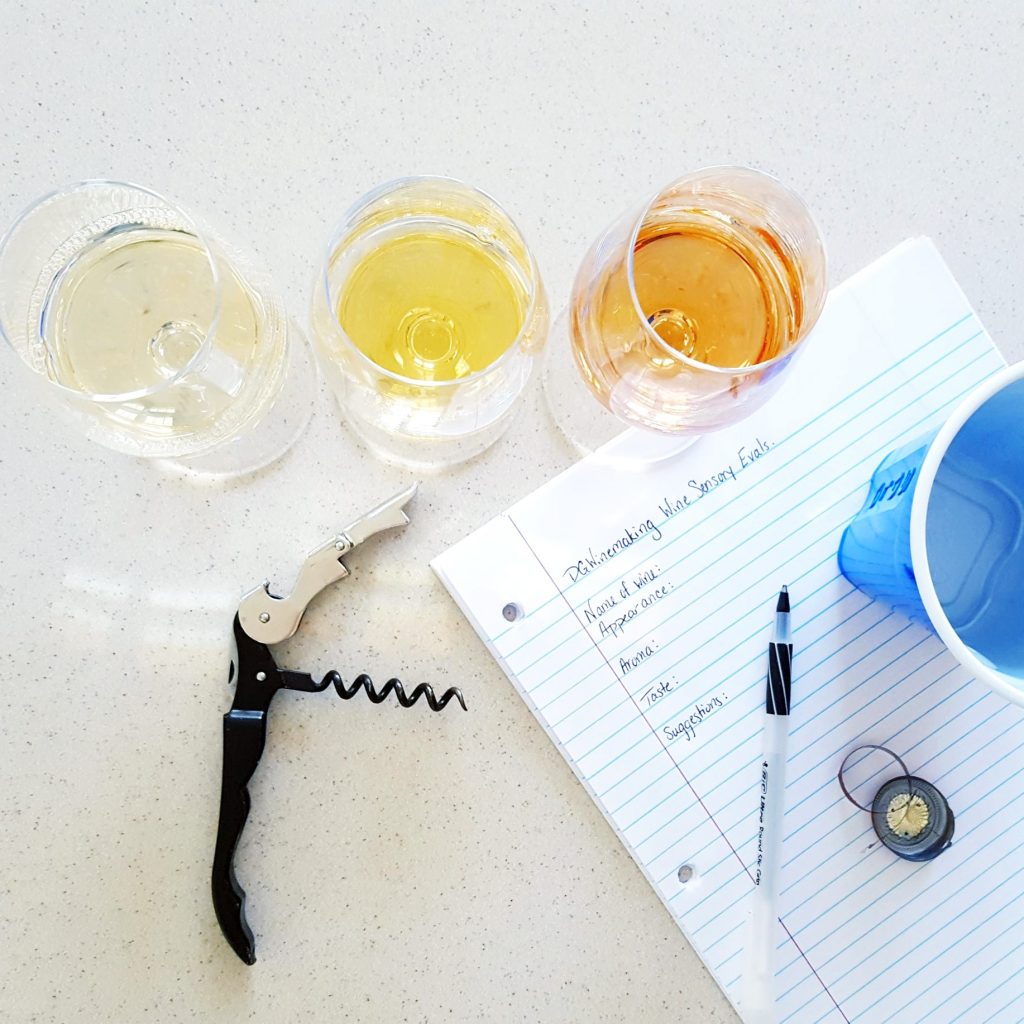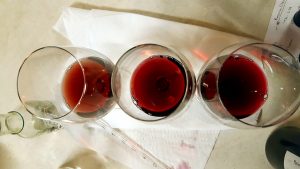
Photo by: Denise M. Gardner
In the world of winemaking, fining agents are what are known as “processing aids.” Unlike ingredients or additives, which stay in the wine after their addition, processing aids do not remain in the wine. Or, if they do, it is at such negligible concentrations that they may be unmeasurable.
Nonetheless, the use of certain fining agents, especially animal-based fining agents like gelatin (often pork-based) or caseinate (a milk protein), has become less trendy in winemaking practices. Many winemaking suppliers now offer plant-based alternatives to animal-based fining agents. Though, efficacy of each plant-based alternative is quite variable.
To complicate the use of fining agents further, many suppliers offer many combinations or mixtures of various fining agents.
And, truth be told, to many winemakers this is often confusing.
Which fining agent does the winemaker actually need in order to fix the wine?
Does the winemaker even need the fining agent at all?
If they do need a fining agent, which one is going to work? Because, let’s face it, time is money and most of us are looking to reduce extraneous processes if they aren’t going to be effective.
Do you need an easy go-to guide for fining agents?
This month, DG Winemaking is releasing the first Production Guide on Fining Agents. This table-like Production Guide breaks down the most common fining agents used in wine:
- Bentonite
- Carbon
- Caseinate
- Chitosan
- Egg White Protein
- Gelatin
- Isinglass
- Kieselsol
- PVI/PVP
- PVPP
The Production Guide breaks each fining agent into its primary purpose (what does the fining agent target?) as well as useful tips for when a winemaker is ready to use that fining agent. It’s a quick reference to winemakers looking to address common wine problems such as
- Protein instabilities
- Excessive astringency
- Wine clarification
- Aroma removal
- Color removal
- Heavy metal removal
This Production Guide is the first of its kind in that it breaks down the primary purpose of the fining agent, and potential secondary purposes to help remove the guess work with wine fining.
When it comes to plant-based alternatives and mixtures of fining agents, winemakers often have to rely on the information provided by their enological supplier of choice. But, they can then use this Production Guide as a quick cross-reference to the supplier information.
Currently the Production Guide: Fining Agents Defined is available to all DGW Members and Clients.
When should a winemaker use a fining agents?
Unlike wine additives such as tannins, polysaccharides, or gums, fining agents are stripping something from the wine. In comparison, the sensory or chemistry effect from additives is due to the ingredient’s addition.
For example, bentonite is commonly added to white and rosé wines to remove proteins that are unstable at specific temperatures, which leads to a visual haze. After the proteins are removed from the wine, bound to the bentonite, the wine is considered “protein stable.”
Can additional components get removed from the wine with the bentonite addition?
Sure. But the secondary effects caused by the addition and removal of bentonite are usually negligible or less important than removing unstable wine proteins.
Fining agents are useful when a component in the wine is unstable or undesirable, and the removal of that component enhances wine quality.
In general, I am not a proponent of fining every wine, especially if the wine does not need fined. The reason for this is because while many fining agents do have a primary target component for removal, unnecessary fining agent addition can lead to a degradation in wine quality. The excess addition of a fining agent can remove varietal characters, change the wine’s sensory characteristics, or cause off-flavor development, depending on the fining agent being used and the concentration in which it is used.
Common wine problems that often require the use of fining agents include:
- Wine oxidation
- Unstable color in the wine
- Smoke tainted wines
- Protein instabilities
- Excessive wine astringency
- Heavy metal removal, especially after the use of copper sulfate additions
- Wines difficult to clarify
Some tips for using fining agents
If a wine requires some fining, a winemaker should always start with bench trials. Most suppliers offer sample sizes for free or at a minimal cost, which can be used for bench trial assessments. While there may be 20+ fining agents that a winemaker could use to solve the wine’s problem, I recommend choosing up to 4 or 5 fining agents in a single bench trial.

Photo by: Denise M. Gardner
Make a list of the possibilities and then determine the ones that are most-likely to solve the problem. If you need assistance with this, winemaking consultants like myself or technical sales representatives associated with the product supplier are useful.
Once you receive your samples, prepare the bench trials according to the supplier’s directions. Each fining agent has a unique set of instructions for preparation and handling. Furthermore, some fining agents require longer contact time with the wines compared to others.
If possible, I may conduct a fining bench trial by initially setting up a series of 375-mL bottles with the fining agent treatments. As the contact time approaches, I rack the sample off of the fining agent into a 250-mL plastic bottle, seal, and refrigerate (if that is okay for the trial) until the remainder of the treatments are ready.
Often, a fining agent trial will not result in the elimination of a wine problem. However, the winemaker should look for the wine with:
- The greatest effect on the problem,
- While also maintaining wine quality.
It’s possible that after this first set of bench trials, a second set of bench trials with the fining agent of choice may need executed in order to determine the appropriate dosage rate for the fining agent on that wine.
Finally, some fining agent additions occur during later stage processes, such as right before filtration. If this is the case, I encourage winemakers to set up bench trials for all those late stage processes with the samples of wine that have been treated with the fining agent. For example, if the wine requires a sugar addition, I may use the sample of wine that’s been treated with the select fining agent in order to determine the sweetness concentration for that wine. Doing all of those bench trials before the fining agent is added to the wine creates a winemaking plan for the winemaker. Plus, the winemaker also knows that the fining agent is not only effective, but conducive for future plans for that wine.
Once decisions are made, the winemaking process itself becomes more efficient. Thus, the winemaker can go from adding the fining agent, removing the wine off of the fining agent (post-settling), to any late process additions like a sugar addition and filtration. The wine can go right to bottle without any stops in between processes.
Do you need more help with making your winemaking decisions?
Choosing the right fining agent or order or process operations for a wine can be tricky. It may also require a lot of time allocated towards trial and error.
Denise Gardner Winemaking offers the Production Guide: Fining Agents Defined to both DGW Members and Clients.
For more information on how to access this and other Premium Content resources on the DGW website, please refer to the Membership Services page, here, available to the winemaking community. Any questions can be directed to info@dgwinemaking.com.
The views and opinions expressed through dgwinemaking.com are intended for general informational purposes only. Denise Gardner Winemaking does not assume any responsibility or liability for those winery, cidery, or alcohol-producing operations that choose to use any of the information seen here or within dgwinemaking.com.
